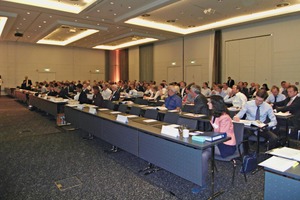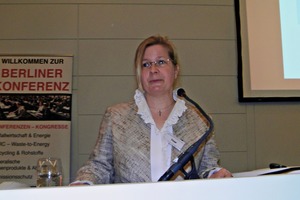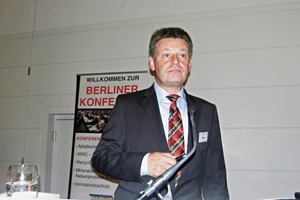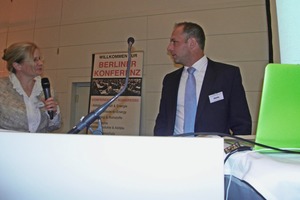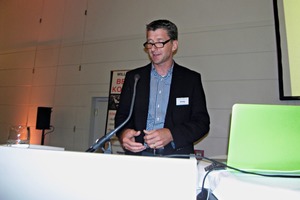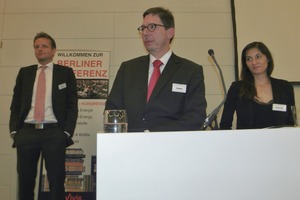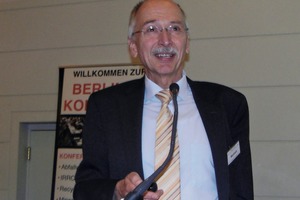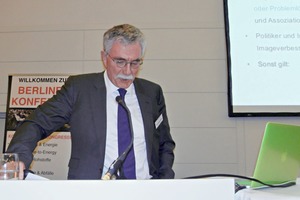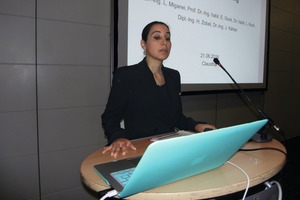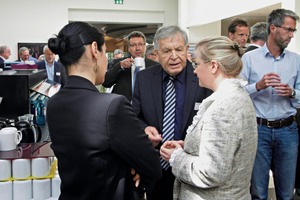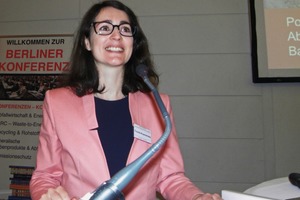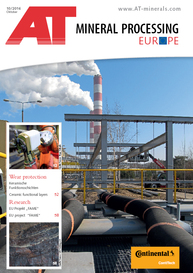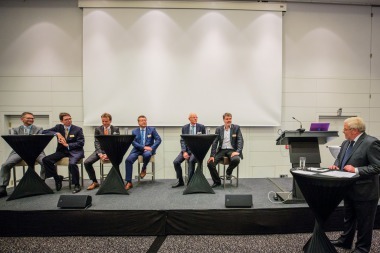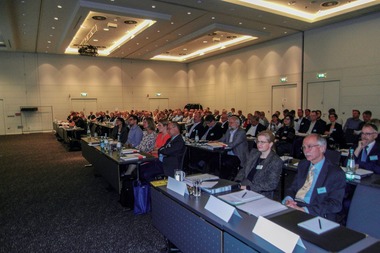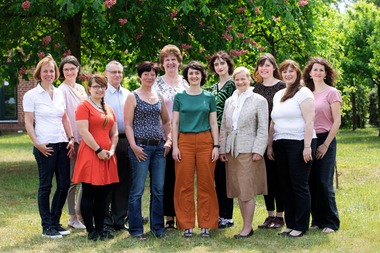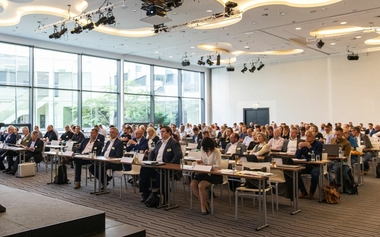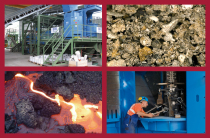Framework Ordinance on the home straight?
The third Berlin “Mineral Byproducts and Waste” conference, held on 20 and 21 June 2016, was awaited with great anticipation, the participants looking forward, in particular, to hearing about new developments and, perhaps, even conclusive statements on the Framework Ordinance for Groundwater/Substitute Building Materials/Soil Protection (German: MantelV). Even the very agenda gave a hint, however, that the final word has still not yet been spoken on this subject, of such great importance to the substitute and recycled building-materials sector. The industry showed great interest, and Elisabeth Thomé-Kozmiensky M.Sc., of the conference organiser, TK Verlag Neuruppin, was thus again pleased to welcome more than 300 participants from both German and foreign industry, scientific institutions and authorities. The first day of the conference focussed in a plenary session on legal and strategic problems and questions, while the second day examined specific technical topics in four sections.
Plenary session
Chairperson Dr.-Ing. Stephanie Thiel, of vivis Consult GmbH, Neuruppin, set the mood of the congress participants for the meeting, emphasising that Germany needs at last to have unequivocal regulations on the environmentally safe handling and use of substitute and recycled building materials. Substitute building-materials regulations have been under discussion for well over ten years, and the third working draft of the “MantelV” was submitted in 2015; a simulation exercise was then started, to validate the draft regulations for their practicability and enforceability. The simulation exercise, which will also take the anticipated changes to materials flows into account, is to conclude with results which are to culminate in the draft bill in September of this year. Only then will the bodies involved be able to decide, with the consequence that some good time will still elapse before an Act can be passed. The Federal Ministry of the Environment is, nonetheless, planning enactment of the MantelV during this legislative period. Dr. Thiel drew attention to Germany’s Austrian and Swiss neighbours, whose corresponding regulations have already come into force this year, with the result that a number of the subsequent plenary-session papers were able to discuss initial experience with them.
Dr.-Ing. Heinz-Peter Eisen, of ThyssenKrupp Steel Europe AG, Duisburg, firstly presented, in the form of an impressive example from a German steel corporation, a strategy for the valorisation of mineral byproducts and waste, taking account of the EU’s new Circular Economy Package (KOM [2015] 614). The advances made in the German steel industry are worthy of note: in 1940, no less than 980 kg of slag occurred in production of 1000 kg of hot metal (“pig iron”), whereas process optimisations have now reduced this figure to only 250 to 300 kg. The statistics for valorisation are no less impressive: 72 % of slags and mineral byproducts are sold, 22 % (iron-containing byproducts) are recycled, and only 6 % now require landfill disposal. The speaker cited further examples to show how his company continues to search for new marketing and utilisation potentials for the frequently (due to the production processes) extremely fine byproducts, in order to close even more materials circuits.
Senior Government Officer Michael Heugel, of the federal environment ministry in Bonn, examined initial results from the simulation exercise on valorisation questions under the Substitute Building Materials Regulations (ErsatzbaustoffV) and the Federal Soil Protection and Contaminated Sites Ordinance (BBodSchV). He explained the procedure (contributions by Prognos AG and the Öko-Institut e.V., formation of a project supervisory body from associations [construction, disposal, water management], administration, involvement of affected persons/districts) and the planning of the simulation exercise. The project supervisory body has met three times up to now, permitting the identification of important questions but not, however, the elaboration of any solutions. Despite the many issues outstanding, submission of a draft bill is planned for the autumn of this year.
The status of discussions on the MantelV, with the emphasis on amendment of the BBodSchV regulations, was the focus of the address by Hon.-Prof. Dr. Jens Utermann, of the Federal Environmental Bureau, Dessau-Roßlau, who examined both the structural and content changes vis-à-vis the BBodSchV as in force since 1999. The selected aspects of content changes as presented include the expanded scope of regulation of the precautionary values, prevention of hazards and follow-up provisions. The TOC limits for landfill disposal (< 1 % by mass as TOC400), as well as the more stringent limits for As, Cd and Tl, are also heatedly disputed topics. The sensitivity of this subject was illustrated not least of all by the subsequent impassioned discussions by those affected.
The fundamental principles for the application of the de minimis threshold (DMT) at the water-law/waste-law/soil-protection law interface were the focus of the paper presented by Dr. Andreas Zeddel, of the Schleswig-Holstein Ministry of Energy, Agriculture, the Environment and Rural Areas, in Flintbek. Decisive changes occur here, too, as a result of the legal changes and the knowledge gained since the DMT derived by the federal state alliance in 2004, and these were highlighted and discussed.
Finally, Principal Undersecretary Peter Dihlmann, of the Baden-Württemberg environment ministry, reported on experience gained from interim enforcement, under the title “Between M20 and framework ordinance”. His critical examination of the legal provisions for the disposal and/or valorisation of construction waste under the old (M20) and the planned regulations (MantelV) brought him to the concluding result that the specific core statements of legislation must not give rise to any contradictions and must create space for the exercise of discretion. The fears universally expressed by the industry that the third working draft of the MantelV could result in even greater stringency and a disposal risk are to a good degree understandable. A quantitative evaluation will be possible only once the results of the simulation exercise are available, however.
Initial experience with the implementation of the new Austrian building-materials recycling regulations were outlined by Dipl.-Ing. Roland Starke, of the Vienna Ministry of the Environment. It has become apparent that much has been achieved, particularly in terms of quality assurance and legal certainty for all applicable requirements. The effects on recycling rates as yet remain unknown. Retrospective improvements can be discussed, particularly in the field of private valorisation on the construction site, adjustment of limits to take account of geogenically induced total/eluate contents, and in the field of restrictions on application. Consideration is being given to a new occupation, with corresponding opportunities training as a “decommissioning specialist”.
An appropriate insight into Swiss conditions was given by Dipl.-Ing. Ursin Ginsig, of Eberhard Recycling AG, Kloten/Switzerland, who spoke on the practical implementation of his country’s new regulations on the avoidance and disposal of waste (VVEA) and on the effects on the flow of construction waste. His assessment – substantiated by many citations from the VVEA – was also, in principle, positive. A greater level of routing of construction waste for reutilisation, and higher recycling rates, can be expected. The enforceability of the regulations is, at best, dubious at many points, in view of the construction-waste flow, since there is a lack of clear formulations. The industry aims to make its contribution for the missing basic principles (state-of-the-art and aids to enforcement).
Statements
The conclusion of the morning session was provided by the responses of the relevant associations and other bodies to the current working draft for the MantelV:
● The BRB federal building-materials recycling association and Association of Waste Incineration Slag Processing Organisations (IGAM), of Duisburg – Ass. Jur. Jasmin Klöckner, Managing Director
● FEhS Building Materials Institute, Duisburg – Thomas Reiche, managing director of the FEhS
● DGAW – German Waste-Management Association – Dr.-Ing. Alexander Gosten, holder of procuration at the BSR Berliner Stadtreinigungsbetriebe municipal hygiene authority, Berlin, and Vice‑President of the DGAW
● Jasmin Klöckner emphasised that the BRB continues to welcome the efforts at achieving a uniform MantelV throughout Germany. The current status is a step in the right direction. The results of the simulation exercise must be incorporated into the regulations. The BBodSchV, in particular, requires unequivocal revision, however, and the Substitute Building Materials and Landfill Regulations further harmonisation, however. The federal disposal, water and raw materials association (BDE) and the federal building-materials recycling association (BRB) have submitted corresponding statements. Rapid completion is demanded.
● Thomas Reiche declared that the steel industry is, in principle, also in favour of the uniform MantelV throughout Germany, with a number of “buts”, however. Amendments are necessary, since 40 % of the substitute building materials currently produced will otherwise end up in landfills. 95 % of the waste currently routed for utilisation would in future be excluded from this. Adjustment of the limits for certain substances is also necessary, Reiche noted, since 2 million t of substitute and recycled building materials will otherwise be landfill dumped. The purpose of the simulation exercise also appears incomprehensible.
● Dr. Alexander Gosten was extremely critical, fearing that recyclable mineral waste from municipal facilities would, under MantelV, have to be landfill dumped, resulting in higher charges. The häre aim of the policy of achieving higher recycling rates will not be attained with the MantelV in its present form. Failure to take account of geogenic factors is a further deficit. Gosten’s conclusion: the draft bill must not be legally established in this form.
All three representatives questioned the plausibility of the envisaged limits during the subsequent discussion. There is obviously still much to do if all interested parties are to be satisfied with the MantelV.
The papers presented during the afternoon session also mainly took the form of critical observations on the third working draft of the MantelV. “Dark clouds or a silver lining on the horizon?” asked Principal Undersecretary Dr.-Ing. Heinz-Ulrich Bertram, of the Lower Saxony environment agency, Hanover, and cited numerous examples to illustrate the shortcomings of the substitute building materials regulations integrated into it. This speaker claimed that the draft contradicts the fundamental principle of sustainability, since the aim of correct, zero-harm valorisation of mineral waste is not achieved and worries concerning significant environmental hazards are aroused. Bertram’s conclusion: there is a need for significant revision, there are dark clouds on the horizon, but the resolution of the deficits is feasible. Berthold Heuser, of REMEX Mineralstoff GmbH, Düsseldorf, spoke from the viewpoint of a plant manager on 2016 recycling practice against the background of unsatisfactory regulatory processes and the necessity of uniform provisions for substitute building materials throughout Germany, due to the distortions of competition at state boundaries (differing landfill disposal regulations). Heuser opined that “the dark clouds are already here”, substantiating his statement with numerous examples, such as problems of acceptance in the case of substitute building materials, favouring of natural products, the reticence of public spending and falling returns on sales.
Dr.-Ing. Henning Schliephake, of Georgsmarienhütte GmbH, Georgsmarienhütte, examined the question of whether legal initiatives on resources efficiency and the circular economy at national and European level are coherent from the steel industry’s viewpoint. He drew the conclusion that harmonisation and implementation of EU legislation, and also the implementation of national legislation, are vital. In conjunction with the new substitute building materials regulations, Schliephake considers Germany’s 50 % utilisation of slags to be endangered. His plea: “The political world must study science, since it is vitally applicable, and cannot be ignored.“
Important topics in conjunction with the MantelV are current developments in German and European landfill law, as was stated by Dr.-Ing. Bernd Engelmann, of the Federal Environmental Bureau, Dessau-Roßlau. He firstly clearly established that – contrary to the wishful thinking of many politicians – landfills will continue to be needed as long as there is mineral waste which is either contaminated and cannot be decontaminated on economically rational criteria or cannot, in any case, be valorised. The changes up to now in the Landfill Regulations, changes in chemicals law and in the hazard characteristics of waste, the European Circular Economy Package, including the proposed changes to the Landfill Directive, and also the need for landfills and waste-management planning in Germany, were all discussed. One fact is particularly problematical in conjunction with the MantelV: the Landfill Regulations specify a different eluate process than required in the substitute building materials regulations. This “limit conflict” appears insoluble at present. Nor can any ambitious provisions for landfills be expected from the EU.
Technical papers
A separate series of papers had been arranged for the field of landfills, which again enjoys greater relevance in conjunction with the MantelV, for the four parallel events focussing on scientific and technical topics on the second day of the conference. Technical processes, scientific investigations, projects, and also operating experience and plants, were all examined in the individual sections. Only a few of the plethora of papers can be mentioned and outlined in brief by way of example in the scope of this report.
1. Preparation of incineration ash and recovery of fly ash
Prof. Dr. Rainer Bunge, of the HSR University of Applied Sciences Rapperswil, Switzerland opened this section with an extremely well presented overview paper on the preparation of waste-incineration ash. Dipl.-Ing. Florian Huber, of the Vienna University of Technology, focussed on an alternative concept for fly-ash management by the City of Vienna, while Prof. Dr.-Ing. Thomas Pretz, of the RWTH Aachen University, discussed the state-of-the-art in the preparation of the fine incinerator bottom ash (IBA) fraction of < 10 mm. This fraction has gained greater importance with the shift of emphasis in the preparation targets for IBA toward recovery of metals. Preparation processes, including modified classifying and non-ferrous metal sorting technologies, have increasingly moved into higher fineness ranges. The limit on the use of conventional dry-mechanical methods is now at around 2 mm. New developments utilise an extraction process incorporating impact technology for subsequent sorting. The lower particle-size limit has now actually been moved into the around 0.5 mm range. Wet processes are, equally, now also being successfully used for the recovery of metals from ultra-fine fractions.
This subject is also being studied in Switzerland, as Martin Schmidt, of LAB GmbH Zug, Cham, Switzerland, illustrated in his address, entitled “Recovery of metals from the fine fraction of waste-incineration ash”. A wet process for the < 2 mm fraction of waste-incineration slag (incinerator bottom ash and fuel ash), which anyway occurs in wet form, has been developed for this purpose and patented as “RecuLABTM”. The potential for recovery of heavy non-ferrous metals (Au, Ag, Cu and Zn) from the 0 to 2 mm fraction is 0.3 to 0.6 %, referred to the 0 to 100 mm slag input. The cost-effectiveness of this process is greatly dependent on world-market prices. A tower-type pilot plant has already been constructed, and can be integrated without further difficulty into the wet slag-removal system of a waste-incineration plant.
The recovery of feed materials, and of metals from waste-incineration slags, in particular, is also a topic in Austria, with particular attention being directed to the difficult-to-prepare noble metals and stainless steels. Ing. Gerhard Stockinger, of Brantner Walter GmbH, Purgstall, Austria, examined the so-called Brantner Wet Slag Treatment process, and discussed initial operating results from the plant at Hohenruppersdorf, Austria. This process yields metal concentrates for the scrap trade and for Al smelters and Cu refineries. The demetallised slag is suitable, under the legal provisions applying, for highway construction, and can also be used as an admixture for production of concrete. The residual sludge has a high CO2-fixing potential, with the result that it is possible to speak about a “CO2-neutral” waste-incineration plant. Another paper dealing with ash from waste-incineration plants also came from the Netherlands. Ing. Huub Creuwels, of SGS Intron B.V., Sittard, Netherlands, reported on results obtained with processed waste-incineration plant slag as an admixture in the production of concrete paving stones. It is thus possible to replace up to 20 % of sand and gravel with so-called AEC granulate in concrete for structural applications, and up to 50 % in concrete for non-structural use. Quality assurance (additional requirements for bulk density, metallic Al, Zn, sulphate, alkali, etc., contents) and quality control play an important role here.
2. Metallurgical industry byproducts
Iron and steel plant slags – i.e., LD converter, electrical-furnace/stainless-steel slags, and also secondary metallurgical slags – have now been in use in the construction industry, in pavement and highway construction, and in landfill/water-hydraulic engineering, for example, for more than three decades. Thanks to the new substitute building-materials regulations in the MantelV, the use of many of the slags mentioned is no longer possible, since only the highest quality category meets the requirements for classification as a byproduct. Good reason to examine this topic not only politically, but also, and above all, from a technical viewpoint. There was, as a result, no lack of papers on this subject, with its importance for the circular economy, sustainability and the conservation of resources. The address by Dr.-Ing. Dirk Murdersbach, of Max Aicher Umwelt GmbH, Meitingen, et al., who spoke on investigations into the improvement of the properties of electric-furnace slag with the aim of retaining its product status with the corresponding quality features, may be mentioned by way of example. Dipl.-Ing. Frank Dardemann, of Lösche GmbH, Düsseldorf, and his co-authors also focussed on this topic in their paper entitled “Steel and steel-alloy slags – an overview of the technical potentials of preparation technology in the recycling of the metal and mineral fraction”, as did Dr. rer. nat. Michael Dohlen, of thyssenkrupp MillServices & Systems GmbH, Oberhausen (”The use of LD slag in pavement and surfacing engineering”).
Also worthy of mention is the address by Dr.-Ing. Leila Miganei, Prof. Dr.-Ing. habil. Eberhard Gock, Clausthal University of Technology, et al. on “Zero-byproduct processing of slags from the former Mansfeld copper-shale refining operations”. No less than 66 million t of copper-refinery slags, for which there is, even now, no zero-byproduct recycling process, are present in the “Mansfelder Land”. This is a joint project funded by the Federal Ministry of Education and Research and also involving Loser Chemie GmbH. The Clausthal University of Technology’s project concept was examined in this paper. The process is based on mechanical (sorting, comminution and classification), thermal (after-roasting at 800 °C) and wet-chemical (leaching, precipitation, complexing, extraction and crystallisation) process stages. Four products are yielded: blasting agents for corrosion protection, admixture for the cement industry, metal-salt solution (Cu, Ni, Co, Zn, Ce) for the metallurgical industry (recovery of pure metal) and a special fertiliser. The fourth product defrays the costs of the necessary chemicals. Total calculated income (750 €/t of copper slag) permits the anticipation of cost-efficient implementation of this patented process, and there is probably no technical obstruction to commercial implementation.
Philipp Büttner, of the Helmholtz Institute Freiberg for Resource Technology, Freiberg, focussed on the mining spoil heaps of Saxony, also a source of feed materials not to be underestimated, while speaking on the subject of “Re-mining – recovery of strategic metals and other minerals from Saxony’s mining spoil heaps”.
3. Building waste
The topics of the papers in this section were diverse, ranging from the recycling of aerated-concrete rubble, via gypsum-containing waste, up to and including tar-containing highway rubble, the aim being the recovery of the highest-quality recycling products possible, taking economic criteria into account. Dipl.-Ing. Frank Hlawatsch, RWB e.V., Bremen, for example, outlined high-quality valorisation routes for aerated-concrete rubble in mortars and breeze blocks for masonry. The BauCycle joint project, on which Dipl.-Min. Sebastian Dittrich, of the Fraunhofer Institute for Building Physics, Valley, Bavaria, reported, was set up to route the enormous quantities of mineral building waste < 2 mm – no less than around 5 million t/a in Germany – to high-quality reutilisation. Ronald Vogt, of Strabag Umwelttechnik GmbH, Darmstadt, focussed on the processing plant for drywall-panel waste (production waste, cutting waste in the construction, expansion and renovation of buildings) at Deißlingen, which has been in operation since late 2014. This speaker emphasised the importance of the purity of the feed materials for the achievement of a product which can be reused by the gypsum-processing industry. Corresponding sensitivity by both the recycling and the construction firms for the problems involved is therefore necessary. Finally, Dr. Georg Silvers, of Max Wild GmbH, Berkheim, outlined the waste-management and environmental law aspects, and also the potentials, of the preparation of drilling muds from horizontal and vertical drilling operations. Here, too, a provision uniform throughout Germany is vitally necessary for correct disposal. The speaker mentioned the stipulation of uniform quality requirements for recycled drilling fluids (technical and environmentally relevant parameters) as an essential element.
4. Landfills
Interest in these topics was extremely great – even the politicians have had to acknowledge that there will not be a zero-waste society and that it will, instead, in future still be necessary to landfill dump certain quantities of treated waste. The subjects covered in these papers encompassed the decommissioning of landfills, the planning and setting-up of new facilities and the use of existing landfill locations.
Prof. Dr.-Ing. Gerhard Rettenberger, of Ingenieurgruppe RUK GmbH, Longuich, presented an overview paper on the decommissioning of landfills. Ing. Reinhard Göschl, of IUT GmbH, Pitten, Austria, spoke on landfill decommissioning practice, citing the example of a landfill with a filled capacity of 7.5 million m³.
Dr. Ulrich Stock, of LfUG Brandenburg, Potsdam/Groß Glienicke, described the status of planning of landfills for mineral waste in Berlin and Brandenburg. Attorney Dr. Peter Kersandt, Andrea Versteyl, Attorneys, Berlin, spoke on experience in approval and in-court practice in application procedures for new DK 0 and DK I landfill capacity.
The use of existing locations on the “landfill-on-landfill” principle was the subject of the address by Dr.-Ing. Kai-Uwe Heyer, of the Ing.-Büro f. Abfallwirtschaft Prof. Stegmann & Partner engineering consultancy, Hamburg, and PD Dr.-Ing. habil. Albrecht Palm also spoke on this topic, in a paper entitled “Setting-up of a DK II landfill at an existing location”.
Concluding remarks
As expected, the Berlin conference on “Mineral Byproducts and Waste” was this year, once again, notable for its highly topical subjects, highly capable speakers and a broad spread of subjects. Also not to be forgotten is the excellent organisation of the event by the TK Verlag Neuruppin. Great presentation and break discipline also permitted visits to individual papers in the various parallel sections. There were adequate opportunities to exchange experience and opinion, and to clarify unanswered questions in personal conversations, whether in the breaks during the conference or at the evening event, in addition to the discussions which followed the papers. The now traditional international participation of speakers and chairpersons from Austria, Switzerland and the Netherlands is an undoubted benefit which permits insights into the legal framework and also into the technical level of the recycling of mineral byproducts and waste in our neighbouring countries. The necessity of conserving resources and of sustainability again and again results in innovative methods and motivates scientists and technicians to seek solutions for the valorisation of difficult materials. The status of ratification of the MantelV remains unsatisfactory. But – good things take time! With this confidence, we look forward to the next Berlin conference.
The majority of the papers included in the conference agenda can be found in “Mineral Byproducts and Waste 3 – Ash, slag, particulates and building residues”, published by: TK Verlag Karl Thomé-Kozmiensky, Neuruppin 2016, ISBN 978-3-944310-28-2.
The next Berlin conference on “Mineral Byproducts and Waste” will be held on 26 and 27 June 2017.

